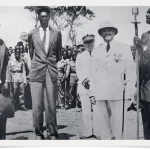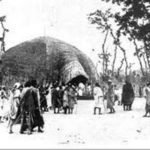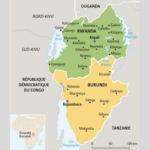Rights In Land
Cultivation and cattle-rearing formed the basis of the Rwanda subsistence economy. Rights in land related to both i.e. cultivation and grazing. While pasture rights excluded cultivation, cultivation rights did not exclude grazing on farmland after the harvest. Maquet and S Nayigiziki (,1957) have categorised the various rights in land according to whether land was recently cleared from the bush or forest or had been under cultivation for some time. The former are called forest regions, the latter rural regions.
Rural areas were distinguished as either ibihutu, ibitutsi or ibikenke. Ibihutu were predominantly agricultural land and were densely populated by cultivators who were either Hutu or “poor Tutsi”. The administrative officers living in these areas herded their cattle on the land of the cultivators after the harvest and on the uncultivated valley marshland. Ibitutsi were less populated areas and were largely pasture land although some cultivators lived there as well. Ibikenke were very sparsely populated areas in which, anyone who had cattle had free access for grazing except in certain parts which were reserved for “official cattle”. The areas referred to as forest regions consisted of recently cleared bush or forest-land which were called ubukonde.
A. Rural Areas
(a) Pasture
Rights to pasture were called ibikingi and sometimes referred to land which was exclusively pastureland and at other times referred to the seasonal grazing rights on agricultural land. These ibikingi or rights to pasture were given by the political chiefs, who acted as representative of the king. The institution seems to have been introduced not long before the arrival of the europeans. The Rwanda attribute the introduction of ibikingi to the grandfather of Rwabugiri, Yuhi, who reigned at the end of the last century. Before the ibikingi rights were introduced there was only common pasture to which all cattle owners had access.The cluster of rights and obligations associated with ibikingi are related to political power not only because of its introduction by the Mwami, but also in as far as thedistribution of these rights lay with the political authorities Ibikingi primarily refers to rights to graze cattle on a certain area granted by the political authorities in exchange for cattle and an annual payment of dues, the amount of which was related to the spatial extension of these rights. But he did not need to pay these goods or render these services himself but could use the labour and goods due to him by his tenants.
However the term ibikingi also referred to the actual area of the concession. When we dealt with the duties of the hill chief, we touched upon these rights.Although the holder of ibikingi land could reserve a part of it for the settlement of cultivators, the concession could neither be subdivided among his heirs nor could he sell parts of it. Those who were thus settled had to pay in regular goods and services and had to allow the ibikingi landholder to graze his cattle on the stubble after the harvest. Normally these cultivators settled on ibikingi land were the holders’ clients. If the holder no longer exercised his rights either because he had no cattle or because he had left the hill, the rights reverted to the political chief, who could allocate these rights to whomever he wanted including his own kin.
These rights differed according to whether they operated in ibihutu, ibitutsi or ibikenke areas.
In ibitutsi zones the concessions involved exclusive rights on certain pastures. In ibihutu zones,, the political chief reserved any pasture still available for himself and his kin and distributed grazing rights only on the cultivators’ land after the harvest, ibikenke zones the chief reserved certain grazing grounds for himself but the rest was free grazing ground for whoever had cattle; no ibikingi rights were needed.
At the death of a person holding ibikingi, the rights passed to his heirs. At the death or replacement of the political chief, rights to hold or allocate ibikingi and the income from already allocated rights passed to his successor who was not necessarily his heir. If an ibikingi land holder who had personal clients settled on his land, left the area and the ibikingi rights were redistributed tosomebody else, the cultivators settled on the ibikingiland did not ipso facto become clients of the new holdernor did they owe him any dues.
(b) Agricultural Land
Lineage holdings were called ingobyi. These referred to land which was exploited communally under the direction of the lineage’ head who allocated any land still available.
If land became vacant either through lack of heirs or because of departure of the current holder, the land returned to the general lineage holding and fell under the authority of the lineage head. He then parcelled out the land to each household according to its need. The land holding of an individual household was called umunani. Although each household (rugo) had its own well defined land, no visible boundary marks were drawn. The lineage head, as holder of the ingobyi land, paid tribute to the Mwami, but neither the amount nor the time for payment were fixed. If an individual member of the lineage had a dispute with the lineage head over rights to umunani land, he could have recourse to a political chief to act as an arbitrator. These disputes were often related to reduction or division of umunani land ordered by the lineage head, due to population pressures.
In such cases of dispute the lineage head was forced to accept the judgement of the political chief, through this action however the discontented umunani holder cut himself off from his lineage and the land rights* he held were henceforth considered as falling under the political authority. It was to the chief, as office holder, that the umunani holder and his descendants thereafter paid in goods (ibihunikwa) and services (uburetwa). The chief could transfer these rights to a third party.He could for instance direct that the services due to him should be rendered to a widow or allocate these rights to his personal clients. These holdings resulting from political intervention were called isambu.
There were several advantages to be gained by the political chief in intervening on behalf of an individual member of a lineage in land disputes.
⦁ More land came under his direct control which resulted in him obtaining goods and
services;
⦁ If for one reason or another isambu land became vacant, it no longer reverted to the lineagebut to the political chief who could re-allocate rights over it in whole or in part, e.g. rights on a banana plantation to one and arable land to another;
⦁ The individual concerned had from then on to pay tax directly to the chief and no
longerthrough the lineage head as in the case of ingobyi land when it was only the lineagehead who was taxed.
The general process of turning ingobyi land into isambu land was gradual and related to the establishment of effective political control by official chiefs who had sufficient influence to implement the transfer. In densely populated areas where no land was available it constituted the only way open to the political authorities to extend their effective control over agricultural land.
If somebody wanted a plot of land in the less densely populated areas where land was still available, the political chief had the exclusive right to grant rights in land and to determine the boundaries, again in exchange for goods and services. Moreover if the land became vacant it reverted to his authority. Rights in land granted in this way were also isambu holdings. However in very sparsely populated areas, e.g. Bugesera, a man could simply occupy a plot without asking and there were no dues attached to it.
However if a neighbour installed himself, the political authorities had to be called upon to indicate the boundaries.
From that moment onwards the holding became isambu land and the holder had to pay uburetwa, i.e. two days’ of work per week and ibihunikwa. This taxation for all isambu holders was different from the taxation to the Mwami (ikoro), which was due twice a year.
By 1900, (in Central Rwanda) the political authority had established its control over land with its concomitant economic benefits for the office holders and the pattern of isambu land had become widespread and was indicative of the influence of the political authority and the lack of lineage influence as regards rights in arable land.
An isambu holder could sublet all or part of his land either on a temporary or permanent basis. Only in the latter case could he build a homestead on the land but this right was only granted to him if he became the holder’s client. It was the isambu holder however and not his settled client who paid the uburetwa and the ibihunikwa to the chief, but he did not need to pay these goods or render these services himself but could use the labour and goods due to him by his tenant to discharge himself of these duties. The client himself could again sublet the whole or part of his land but could not allow his tenant to settle on the land nor could the tenant retain rights over a banana plantation if for instance he left the area. Payment by sub-tenants was exclusively in goods to the Mwami (ikoro)
Because the income of the chief was directly derived from taxation and hence depended on the number of taxpayers, he was not inclined to give too extensive plots of land, but welcomed as many, settlers as possible and tried to provide conditions such that few wanted to leave. This relates to the situation of the land holder of which Maquet remarks: “Il jouissait d’une grande stabilité de fait” (1957, p.353).
Somebody desiring igikingi would approach the chief and make him a gift of a cow. This cow became the chief’s private property and he could use it within the ubuhake system to make a client. Therefore this chief was also quite often thepatron of some of his subjects. In this case it was not only to the benefit of the chief that both functions were held by him but also to the advantage of the client inasmuch as the total of the client-subject obligations were reduced and his political chief was also his protector. Thus the political function allowed office holders to extend the circle of their reliable clients while the clients helped them in upholding their position and were instrumental in the implementation of the chief’s decisions.
If the chief was replaced he remained the patron of his clients but the igikingi holder had to give the new chief a cow (indabukirano) as a gift.
B. Forest Regions
The boundaries of Rwanda had been gradually expanding towards the-North-East and East through clearing of the tropical forest which was the domain of the Twa. Through payment of an often small fee to the Twa lineage head, somebody who wanted to cut down the forest for cultivation was granted a concession which could be quite extensive. The boundaries were clearly marked and the land within these boundaries was called ubukonde land while the holder was called umukonde. As more forest was cut down and family numbers increased, the land obtained was parceled out by the umukonde, or lineage head, to his lineage members.
In some cases several lineage heads were united under one head, the Muhinza. The lineage members did not pay tribute to the umukonde nor did the umukonde pay to the Muhinza. Most of the abakonde and Bahinza paid tribute to the Mwami, although they remained the heads of autonomous corporate groups. The umukonde or the Muhinza allowed non-lineage members to settle in his domain, but this was not on a clientage basis but on a basis of cooperation. No dues in goods or services were demanded but gifts were given, especially by newly arrived settlers. If the holder of ubukonde land left no heir or abandoned his land, the plot returned to the lineage and could be re-allocated by the umukonde or Muhinza. We find some cases in which patrons had sent their clients from central Rwanda to cut down a part of the forest to turn it into pasture. These too were ubukonde land and constituted the first infiltration of Tutsi from central Rwanda into these areas. However this was on a personal and not a political basis.
From this description it is clear that there was a close similarity between ibikingi and isambu land in that both were granted by the political authority. However they differed in that cattle had to be paid only for obtaining ibikingi land. Ubukonde and ingobyi land were similar in that they were both lineage land, generally belonging to Hutu lineages, but differed in that ingobyi land was situated in those areas where the political authority of central Rwanda was established and where there was pressure to turn ingobyi land into isambu land. Until 1900 ubukonde land had escaped these pressures. The holders of both types of land had escaped uburetwa and ibihunikwa taxation although both paid ikoro to the Mwami. In the case of ikoro, the ubukonde paid directly whereas the lineage heads of ingobyi land, insofar as it still existed, paid through the chiefs. It is unfortunate that there are no details as to the extent of ingobyi land in Rwanda around 1900.
The different patterns of rights in land as held either on the basis of allocation by the lineage or by the political authorities had a geographical distribution in Rwanda directly correlated with those areas in which the influence of lineage or political authority were respectively dominant. These different ways in which rights to land could be acquired resulted in tensions when political authorities exerted pressure for the extension of their powers. The peripheral areas had succeeded in resisting these pressures up till the arrival of colonial rule.
It is against this background that we must see the following measures taken by the government.
- The instalment of Tutsi chiefs in the peripheral areas as part of a unified system of administration.
This meant that any land available came under political control, and that land which became vacant no longer returned to the lineage head but to the political chief. This in turn meant that the chief could and in fact did (Pauwels 1967 p.297) install his relations and their cattle or their Tutsi clients and their cattle on the land in terms of occupation by Tutsi. - In 1932 the granting of further ubukonde rights in the forest was forbidden and rights already held could no longer be used for turning the forest into arable land.
- In 1932 universal adult male taxation for the Mwami was imposed. Thus rugo heads who in the ubukonde and ingobyi system had never paid tax were now obliged to start paying. The tax, which required from all adult males three days of labour for the chief and ten days for the sub chief (uburetwa and ibihunikwa), also affected those who had hitherto succeeded in avoiding this taxation which was formerly reserved for isambu holders. Clients settled on ibikingi land who had so far been free of uburetwa and ibihunikwa but who had to work for their patron and give him goods, now had to render both goods and services twice over. Those who had obtained ibikingi land in exchange for a cow had never paid in goods and services as the cow was supposed to be in lieu of this. The government accepted the continuation of this exemption. As a result, many rich Tutsi, who held ibikingi land, in fact neither paid in goods nor in services. Contrary to the actual situation, ibikingi rights were held to be of a private nature as was ubuhake.
However since 1924, no new ibikingi land could be granted and all available pasture was to be held communally under the direction of the chief.
In 1952 uburetwa and ibihunikwa were replaced by payment in money, viz. Art. 20 of the decree of 14.7.52,”Les prestations dues coutumièrement, en nature ou sous forme de travail, aux bami, chefs et sous-chefs sont remplacées par des contributions en argent a leur profit.”
https://uk.amateka.net/rights-in-land/https://uk.amateka.net/wp-content/uploads/2019/11/femme.jpghttps://uk.amateka.net/wp-content/uploads/2019/11/femme-150x150.jpgSocial & cultureCultivation and cattle-rearing formed the basis of the Rwanda subsistence economy. Rights in land related to both i.e. cultivation and grazing. While pasture rights excluded cultivation, cultivation rights did not exclude grazing on farmland after the harvest. Maquet and S Nayigiziki (,1957) have categorised the various rights in land...BarataBarata rpierre@ikaze.netAdministratorAMATEKA | HISTORY OF RWANDA



